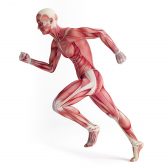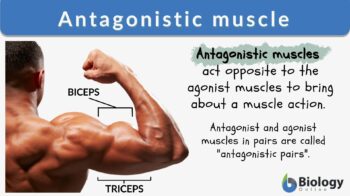
Antagonistic Muscle
n., plural: antagonistic muscles
[ænˈtæɡənɪst ˈmʌsəl]
Definition: a muscle that opposes the action of another
Table of Contents
Definition of Antagonistic Muscle
What does the term “antagonistic” mean? As the name suggests, the word antagonistic means working opposite to the “agonist” or the “primary doer”. In biology, “antagonistic” describes an action or substance that interferes or inhibits the physiological process. In anatomy, the word antagonistic is used to describe a muscle, particularly one that works opposite to the action of the primary muscle. The muscle that works in the opposite direction as that of the primary muscle or agonist muscle, which is engaged in some activity.
So which muscles are agonist and antagonist? The primary muscle that carries out the movement is known as the agonist muscle or the primer muscle. How about the antagonistic muscles? What are they? In contrast to agonist muscles, the muscle that acts in the opposite direction to that of the agonist or the primer muscle is known as the antagonistic muscle.
These antagonistic muscles also balance the tension at the joint by resisting the movement carried out by the agonist muscles. Let us understand the difference between an antagonist muscle and an agonist muscle in Table 1.
Table 1: Agonistic vs Antagonistic muscles | |
|---|---|
| Agonist muscles | Antagonistic muscles |
| Agonist refers to the doer of an action | Antagonist refers to the opposition to action |
| As the name suggests, the agonist muscle is the doer or the primary muscle carrying out the movement | As the name suggests, the muscles that act opposite or complementary to the primary muscles |
| These muscles are accountable for the movement of the bones | These muscles are responsible for returning bones to their original position |
Antagonistic Muscle is a muscle that opposes the action of another. For example, when the triceps oppose the contraction of the flexing biceps by relaxing, the triceps would be regarded as the antagonistic muscle to the biceps whereas the biceps, the agonist muscle. Compare: agonist muscle.
Examples of agonist and antagonist muscles pair are shown in Table 2.
Table 2: Some of the Agonist and Antagonist muscles pair that results in different types of movement | ||
|---|---|---|
| Agonist muscles and their anatomical location | Antagonist muscles and their anatomical location | Associated movement |
| Muscle: Biceps brachii Location: Anterior part of the arm | Muscle: Triceps brachii Location: Posterior part of the arm | Flexing of the forearm by biceps brachii (Agonist) Relax/lengthening by triceps brachii (Antagonist) |
| Muscle: Hamstrings Location: Posterior part of the thigh | Muscle: Quadriceps femoris Location: Anterior part of the thigh | Flexing of the leg by contraction of the hamstrings (Agonist) Lengthening of the quadriceps femoris to extend the limb (Antagonist) |
| Muscle: Combination of flexor digitorum superficialis and flexor digitorum profundus Location: Anterior part of the forearm | Muscle: Extensor digitorum Location: In the posterior part of the forearm | Flexing of the fingers and hand at the wrist is due to the combination of the flexor digitorum superficialis and flexor digitorum profundus (Agonist) Lengthening of the extensor digitorum to extend the fingers and the hand at the wrist (Antagonist) |
Muscle Contraction
What is a muscle action? Muscle action is the transformation in the bodily part that may result in movement and it is due to a muscular contraction. Now, there are different types of contraction movements that can occur in the muscles. Contraction of muscle implies the generation of tension in the muscle and not necessarily the shortening of the muscles. Muscle contraction can occur in the following ways:
- Isometric contraction
A type of contraction wherein no movement takes place, e.g., pushing or pulling any immobile object. In such a case, the tension generated by the contracting muscle is less than the load on the muscle. - Isotonic contraction
A type of contraction wherein movement occurs, e.g., pushing or pulling any object successfully. Herein, the tension generated by the contracting muscle is more than the load on the muscle. These contractions can be further classified as:- Concentric contraction
A type of isotonic contraction wherein the length of the muscle decreases against an opposing load, e.g., lifting a heavyweight in upward direction. Here, the muscle that decreases in length acts as an agonist muscle. - Eccentric contraction
A type of isotonic contraction wherein the muscle increases in length while resisting a load, e.g., keeping weight down in a slow and controlled way. The muscle that increases in length serves as an agonist muscle and carries out the work.
- Concentric contraction
Read: Muscle Contraction Mechanisms – Biology Tutorials
Our body is made up of multiple levers that need to coordinate in order to carry out the body’s efficient movement. The function of the muscles is to transmit the force to the bones via the tendons. As a result, the required body part moves to carry out the intended action. This process is known as muscle contraction.
So basically, contraction of the muscles brings two bones closer to each other. This is also known as the flexing of the muscles that results in the movement of the bones. However, this contraction of the muscle cannot place the two bones back into their original position, i.e., away from each other. Thus, another muscle group acts in the opposite direction to bring the bone back to its original position.
This group of muscles is known as antagonistic muscles. Thus, one group of muscle, i.e., primer or the agonist muscle contracts, enabling the movement of the bone; the antagonistic muscles, then, act in opposite or complementary direction to take the bone back to its original position. Accordingly, to carry out any movement, the main muscle, or the agonist muscle, contracts and shorten in length.
Synergistically, antagonistic muscles work in complementary or the opposite direction, i.e., relaxes, to efficiently complete the action of the primer muscle. Thus, when the agonist or the primer or agonist muscle contracts, the antagonistic muscle relaxes to complete the movement. In summary, the complementary action of agonist and antagonist muscles is the prerequisite for any action to be carried out efficiently.
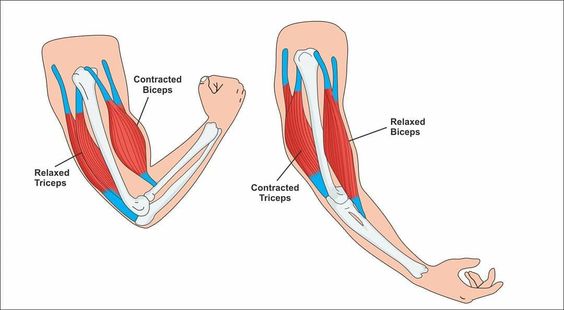
This further implies that the muscle works in pairs wherein one muscle group takes up primer or agonist roles while the other functions as an antagonist.
Some of the commonly used terms to describe the complementary movements are:
For the efficient working of the muscles, fixators assist by providing support and stabilize the joint and the rest of the body. The fixators that assist the agonist are known as a synergist, thus when primer muscle contracts, the synergistic muscle simultaneously contracts. Synergists or synergistic muscles are also sometimes referred to as neutralizers as these muscles help reduce the extra movement induced by the agonist muscle, thus maintaining the working plane of the agonist muscles.
For example, for flexing the elbow joint using biceps, the trapezius muscle acts as a fixator while stabilizing the whole body for the lower abdominal movement, i.e., hip and knee movement, the abdominals act as fixators. The combination and coordination of four categories of the skeletal muscles, i.e., agonist, antagonist, synergist, and fixator, carry out any movement in the body.
Take note that the antagonism of a muscle is not a fundamental or predetermined property of a muscle; it is a role undertaken by the muscle complementary to the current agonist muscle.
Let us understand this with an example.
Imagine a player who is about to take a kick at a soccer ball. Prior to kicking the ball, the knee flexes. The hamstrings contract while the quadriceps relax or lengthen in order to carry out the movement. In this example, the hamstrings take the agonist’s role while the quadriceps serve the role of the antagonist. See Figure 2.
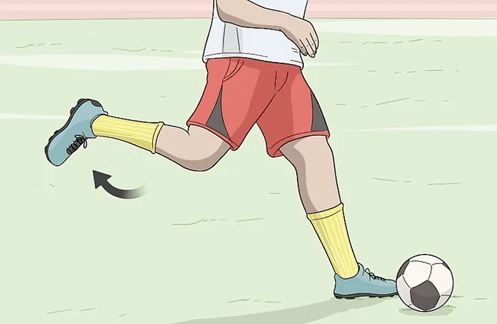
Next, when the player has completed kicking the ball, the knee extends. This also results in quadriceps contracting while hamstrings, relaxing. In this case, the quadriceps become the agonist while the hamstrings are the antagonist in this movement. See Figure 3.
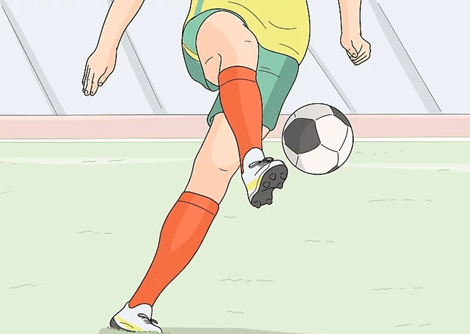
The Function of Antagonistic Muscles
The antagonistic muscles serve two essential functions of the body:
- Uphold the body or limb position, e.g., holding the arm out or standing erect
- Regulating the hasty movement and keeping a check on the limb motion
Any movement in the body is the result of the coordination of action between agonist and antagonist muscles. The co-activation of these two sets of muscles is critical. Our understanding of the concept till now makes it clear that the co-activation of the antagonistic muscle provides resistance to the action of the agonist muscle.
In simpler terms, this resistance is called the stiffness of the joint. A certain level of stiffness to the joint or the resistance to the movement is critically essential to maintaining joint stability under varying load conditions. Thus, the activation of the antagonistic muscles is pertinent for carrying out any body movement.
Examples of Antagonistic Muscles
Antagonistic muscle that is paired with an agonist muscle is referred together as antagonistic pairs. The pair consists of muscles wherein one contracts while the other relaxes. Some of the antagonistic pairs are as follows:
- Biceps and triceps
- Gluteus maximum and hip flexors
- Hamstrings and quadriceps
- Pectoralis major and latissimus dorsi
- Gastrocnemius and tibialis anterior
- Abductor and adductor
Now let’s see a few examples of antagonist muscles to understand better the action of a pair of muscles to aid a movement.
In order to extend the leg at the knee, the quadriceps femoris, which is a combination of four muscles in the anterior part of the thigh, acts as an agonist or primer muscle when activated. Simultaneously, a set of antagonistic muscles — the hamstrings in the posterior part of the thigh – become activated to aid this movement. Contrarily during the flexing of the leg at the knee, the hamstrings contract and act as agonist muscles while the quadriceps femoris relax and lengthen to aid the movement and act as an antagonistic muscle.
From the above discussion so far, it is evident that every muscle has an opposing muscle group for it to function appropriately and keep the body in a balanced condition.
The opposing or antagonistic pairs include:
- Deltoids and Latissimus Dorsi in shoulder and upper back
- Pectoralis Major and Trapezius in the chest and upper back
- Abdominals and Erector Spinae in the stomach and lower back (core)
- Iliopsoas and Gluteus Maximus in hips for both flexion and extension movement
- Hip Adductors and Gluteus Medius in hips for moving legs in/out to the side
- Quadriceps and Hamstrings in the thigh for extension and flexion from the knee
- Tibialis Anterior and Gastrocnemius (calf) in the lower leg
- Biceps and the Tricep in the upper arm (from the elbow)
- Some of the minor opposing muscles present in the wrists, ankles, and neck. The extensors and flexors move the neck forward and back or side to side; the extensors and the flexors in the wrists and ankle are responsible for their movement.
Try to answer the quiz below to check what you have learned so far about antagonistic muscles.
References
- Baratta, R., Solomonow, M., Zhou, B. H., Letson, D., Chuinard, R., & D’Ambrosia, R. (1988). Muscular co-activation. The role of the antagonist musculature in maintaining knee stability. The American journal of sports medicine, 16(2), 113–122. https://doi.org/10.1177/036354658801600205.
- Gorkovenko, A. V., Sawczyn, S., Bulgakova, N. V., Jasczur-Nowicki, J., Mishchenko, V. S., & Kostyukov, A. I. (2012). Muscle agonist-antagonist interactions in an experimental joint model. Experimental brain research, 222(4), 399–414. https://doi.org/10.1007/s00221-012-3227-0
- Onushko, T., Schmit, B. D., & Hyngstrom, A. (2015). The Effect of Antagonist Muscle Sensory Input on Force Regulation. PloS one, 10(7), e0133561. https://doi.org/10.1371/journal.pone.0133561
- Jarić, S., Ropret, R., Kukolj, M., & Ilić, D. B. (1995). Role of agonist and antagonist muscle strength in performance of rapid movements. European journal of applied physiology and occupational physiology, 71(5), 464–468. https://doi.org/10.1007/BF00635882
©BiologyOnline.com. Content provided and moderated by Biology Online Editors.

